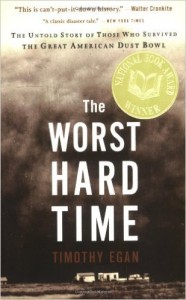 On April 14, 1935, the biggest dust storm on record descended over five states, from the Dakotas to Texas. The Dust Bowl was the product of reckless, market-driven farming that had so abused the land that, when dry weather came, the wind lifted up millions of acres of topsoil and whipped it around in “black blizzards” that were like a biblical plague. But the plague was man-made: the plains weren’t suited to farming, and plowing up the grass to plant wheat, along with a confluence of economic disaster—the Depression—and natural disaster—eight years of drought—resulted in an ecological and human catastrophe that Pulitzer Prizewinning New York Times journalist and author Timothy Egan details with stunning specificity. The dust storms that terrorized America’s High Plains in the darkest years of the Depression were like nothing ever seen before or since, and the stories of the people that held on have never been fully told. The Worst Hard Time paints an unforgettable picture of a society in “terminal disorder”: banks closed, stores bankrupt, people bartering eggs for shoes, hospitals that could not be reached on roads impassable with dust. The Worst Hard Time won the 2006 National Book Award for non-fiction. It is a searing history of the economic and ecological collapse during the 1930s. With Egan’s powerful writing, this account will long remain in readers’ minds. This was a nightmare for the ages and a time when life and hell were the same thing.
On April 14, 1935, the biggest dust storm on record descended over five states, from the Dakotas to Texas. The Dust Bowl was the product of reckless, market-driven farming that had so abused the land that, when dry weather came, the wind lifted up millions of acres of topsoil and whipped it around in “black blizzards” that were like a biblical plague. But the plague was man-made: the plains weren’t suited to farming, and plowing up the grass to plant wheat, along with a confluence of economic disaster—the Depression—and natural disaster—eight years of drought—resulted in an ecological and human catastrophe that Pulitzer Prizewinning New York Times journalist and author Timothy Egan details with stunning specificity. The dust storms that terrorized America’s High Plains in the darkest years of the Depression were like nothing ever seen before or since, and the stories of the people that held on have never been fully told. The Worst Hard Time paints an unforgettable picture of a society in “terminal disorder”: banks closed, stores bankrupt, people bartering eggs for shoes, hospitals that could not be reached on roads impassable with dust. The Worst Hard Time won the 2006 National Book Award for non-fiction. It is a searing history of the economic and ecological collapse during the 1930s. With Egan’s powerful writing, this account will long remain in readers’ minds. This was a nightmare for the ages and a time when life and hell were the same thing.
